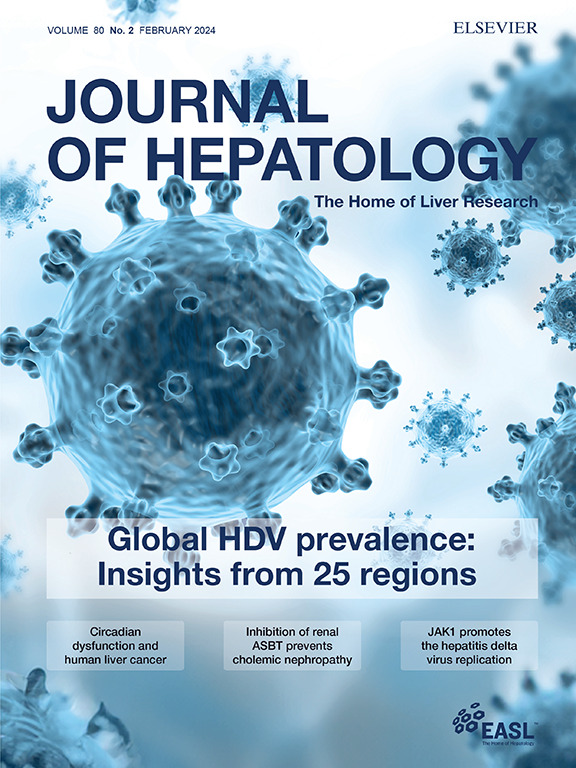Unpicking the senescence paradox in MASLD-associated HCC
IF 26.8
1区 医学
Q1 GASTROENTEROLOGY & HEPATOLOGY
引用次数: 0
Abstract
Section snippets
Background and context
Patients with MASLD are at risk of progressive liver disease and the development of hepatocellular carcinoma (HCC). In response to chronic injury, hepatocytes can become senescent, a state of cell cycle arrest. The accumulation of senescent hepatocytes correlates with fibrosis stage and predicts adverse clinical outcomes in patients with metabolic dysfunction-associated steatotic liver disease (MASLD).1,2 Senescent hepatocytes secrete a range of factors (called the senescence-associatedObjectives, methods and findings
In a recent article by Gu et al. in Nature, the authors aimed to address the question of how metabolic dysfunction-associated steatohepatitis (MASH) can simultaneously increase HCC risk whilst inducing replicative senescence in injured hepatocytes.6 They focussed on the enzyme fructose-1,6-bisphosphatase 1 (FBP1), a regulator of gluconeogenesis which has been shown to protect against HCC.7,8 Using immunohistochemistry of an HCC cohort and analyses of large HCC databases, the authorsSignificance of findings
This is a complex study which has shed new light on the kinetics of senescent hepatocytes in MASLD and HCC. The data presented results in a proposed model where MASH initially induces cellular stress and DNA damage, leading to FBP1 upregulation, p53 elevation and hepatocyte senescence, which initially prevents propagation of mutations and HCC development. However, in a subpopulation of disease-associated hepatocytes, ongoing stress, alterations in metabolic function and epigenetic modulationsFinancial support
P.R. was funded by an MRC Senior Clinical Fellowship (MR/W015919/1).Conflict of interest
The author of this paper declares that they do not have any conflict of interest.Please refer to the accompanying ICMJE disclosure forms for further details.揭开masld相关HCC的衰老悖论
背景和背景MASLD患者有进展性肝病和发展为肝细胞癌(HCC)的风险。作为对慢性损伤的反应,肝细胞会衰老,这是一种细胞周期停滞的状态。衰老肝细胞的积累与纤维化阶段相关,并预测代谢功能障碍相关脂肪变性肝病(MASLD)患者的不良临床结果。1,2衰老的肝细胞分泌一系列因子(称为衰老相关因子)。在Gu等人最近发表在《自然》杂志上的一篇文章中,作者旨在解决代谢功能障碍相关的脂肪性肝炎(MASH)如何同时增加HCC风险,同时诱导受损肝细胞的复制性衰老的问题他们重点研究了果糖-1,6-二磷酸酶1 (FBP1)酶,这是一种糖异生的调节剂,已被证明可以预防HCC。7,8通过对HCC队列的免疫组织化学和对大型HCC数据库的分析,作者发现的意义这是一项复杂的研究,它为MASLD和HCC中衰老肝细胞的动力学提供了新的视角。所提供的数据表明,MASH最初诱导细胞应激和DNA损伤,导致FBP1上调,p53升高和肝细胞衰老,这最初阻止了突变的传播和HCC的发展。然而,在疾病相关肝细胞亚群中,持续的应激、代谢功能的改变和表观遗传调节。由MRC高级临床奖学金(MR/W015919/1)资助。利益冲突本文作者声明他们没有任何利益冲突。详情请参阅随附的ICMJE披露表格。
本文章由计算机程序翻译,如有差异,请以英文原文为准。
求助全文
约1分钟内获得全文
求助全文
来源期刊

Journal of Hepatology
医学-胃肠肝病学
CiteScore
46.10
自引率
4.30%
发文量
2325
审稿时长
30 days
期刊介绍:
The Journal of Hepatology is the official publication of the European Association for the Study of the Liver (EASL). It is dedicated to presenting clinical and basic research in the field of hepatology through original papers, reviews, case reports, and letters to the Editor. The Journal is published in English and may consider supplements that pass an editorial review.
 求助内容:
求助内容: 应助结果提醒方式:
应助结果提醒方式:


